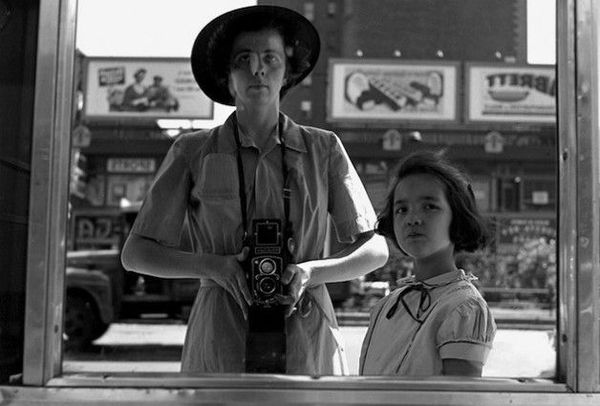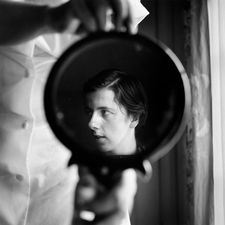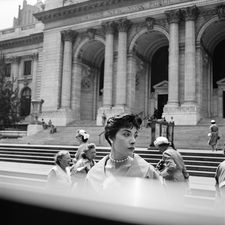 |
| Finding Vivian Maier |
Siskel - who has a long history in television producing - has the sort of energy you wish you could bottle and it's easy to imagine how he also came to be fascinated by Maier's story. He explains that Maloof was looking for a partner on the project and got in touch with Curb Your Enthusiasm star Jeff Garland, who also happens to be a photographer and photography collector. Garland, in turn, got in touch with Michael Moore, who recommended Siksel for the job.
"Michael is a mutual friend, but also my mentor," says Siskel. "I started out making television shows and worked on Bowling For Columbine with Michael years and years ago."
As it turned out, Garland already new Siskel independently and so the way to tell Maier's story emerged. But although she was still virtually unknown in terms of world recognition, when it came to her own material, it was a daunting prospect.
"Not only were there 100,000 photographs but there were close to 100 hours of Super 8 footage and audio recordings that Vivian had made," says Siskel "all of which would become part of the storytelling of the film because with the subject no longer alive, the next best thing is to have that person in their own words - we had audio. And you can feel her sensibility, her ideas behind the camera and maybe even more, you can feel a living, breathing human being when they're shooting Super 8 footage."
There are moments in the documentary when it seems that Maier had become quite reclusive, particularly at the end of her life, but Siskel says she was always keen to find out what was going on.
 |
| Vivian Maier self-portrait Photo: Vivian Maier |
Documentaries are always interesting in terms of what they leave out as much as what they include - how did Siskel make those choices, and why was the story of two boys who paid for Maier's home in her later years not present in the film?
"They are in the film, in the Super 8 footage," says Siskel. "Those boys were very close to Vivian - it was the first family she took care of in Chicago. We did interview them initially but they chose not to be in the film ultimately and asked us to remove them. Partly, I think because the publicity around the story and around the film had got to the point where they were being contacted all the time by journalists. I think that's probably a consequence of John early on being very free with the information he had gathered.
"I think that's because the real goal from the beginning was to get Vivian's story out there to the public and share it with people. And he was excited about having the evening news interviewing him and it wasn't about keeping the story to ourselves at that point. So, in that sense, our film suffered as a result of the openness with which he approached the story originally.
"We do have someone else telling the story of how the boys took care of her at the end of her life. She was very much alone. She lived alone in that apartment and didn't really have much contact with them. At the end of her life and at various other stages, she was quite difficult, I would say. She accepted their largesse but she did not necessarily want to be very close and it's not as if they were in close contact. They kept up bills on some of her storage lockers. They didn't know about all of them and that's why, when she was injured, she stopped paying the bills on the storage locker and it came up for sale. We would have loved to have had the boys as part of the film, but we respected their decision."
The publicity must certainly have been an issue. When Maloof first Googled Maier there were no returns but as his efforts to put make her more well known gathered pace, that all changed. Google her today and more than 1.5 million results show up.
"It's really that the story was a moving target," says Siskel. "There are really two stories in the film. One is a detective story, an investigation, the mystery of who was this person who took the photos? How did she lead the life she led? She was an artist but she lived publicly as a nanny. How did she do those two things, how did she manage to create all this work and what was it like to be an artist and not share that side of herself?
"The other side of it was documenting John's efforts to share the work of this newly discovered artist with others and have institutions and people recognise the work and, in a sense, as he says, put her in the history books. So his efforts to do that meant that there would be coverage of the story. It wasn't known from the start that would happen but, in success, that did happen. So we started the film about a completely unknown artist and now as we've been sharing it with the public, she's not a rock star but she's pretty well known as photographers go.
"As we were making the film, there was news coverage and we recognised that what we were doing was different. I mean, there was a whole Wikipedia entry that was created by John and the research that we did. We shared it and it was made quite public. If there was going to be a story out there, we wanted it to be accurate.
 |
| One of Vivian Maier's street photographs Photo: Vivian Maier |
Siskel says that he and Maloof agreed from the outset that they would follow the story wherever it led, them. In the case of Maier, they discovered that some of the children she had looked after were left troubled by her treatment.
"When we learned some of the darker sides of Vivian's personality and her history with some of the children, there was a discussion about whether to include that," says Siskel "Just as there was a discussion about whether to include the fact that she lived with with Jeanne Bertrand, the photographer. We chose not to include the fact that she lived with Jeanne Bertrand because she was four years old at the time and we thought it would be misleading to suggest that that was how she became a photographer.
"I think it's more interesting that her mother was a photographer, I think that's more of an influence. She had photographers around her at a young age but, again, very young. Some things we choose to include and some things we choose not to include because, while it's true, it's not interesting."
Finding Vivian Maier is released by Soda Pictures across the UK on July 18. You can read more about Maier's work and the film on the official site and vivianmaier.com.





















